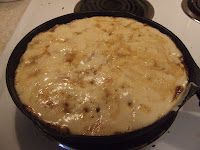 |
| Double Peony (Paeonia sp.) |
Peonies are a favorite spring perennial and though right now spring may not be your first thought, it is a good time to think peonies...
Wild peonies are native to the northern hemisphere and come in three forms, herbaceous, tree, or a hybrid of the two called intersectional. Whether cultivated or wild, peonies flower in the spring with cultivated peonies classified for sale by their flower type which may be as simple as a 'single' or complex as a 'bomb-double'. Flower color may be white, red or yellow with many shades and combinations there of.
Cultivated peonies should be planted or transplanted in the fall (late August - October). (This is why now is the time to be thinking peonies!) If you have a well established peony that has not flowered well or at all for a season or two, it is time to dig it up and transplant it, but be aware that peonies develop
extensive root systems. While digging up the tuber may take time and energy, it is important that you take your time and try to keep the whole root intact. Before digging, cut all the stems back to about 4 inches above the ground and then carefully start digging keeping in mind that the top of the tuber will not be more that two inches below the soil surface.
Rinse off any remaining soil and debris on the tuber with spray from the water hose. You will find that you can divide the old plant into several smaller sections and multiply your planting, or share the floral blessing with friends, family and/or neighbors. As you divide the tuber, remove and discard any diseased or insect infested sections and keep those with 3-5 buds or 'eyes'. A section with less than 3 eyes will take several years to produce a flower and then only in optimal conditions.
Whether transplanting an old plant or planting a newly purchased tuber, be sure to prepare the soil well. Dig a hole twice as deep as you need for your root and fill the bottom with compost and a handful of bone meal. Plant the tuber with the eyes facing the soil surface
no deeper than two inches below the soil surface. Be sure to tamp and water down the soil well as you back fill to
ensure that the tuber is no deeper than two inches or it may not flower. It is a good idea to cover the peony with 3-4 inches of mulch the first winter, especially if it didn't get planted until late October, but peonies do not require mulching beyond the first winter.
Happy Gardening (& Spring Thinking!)! :)
















